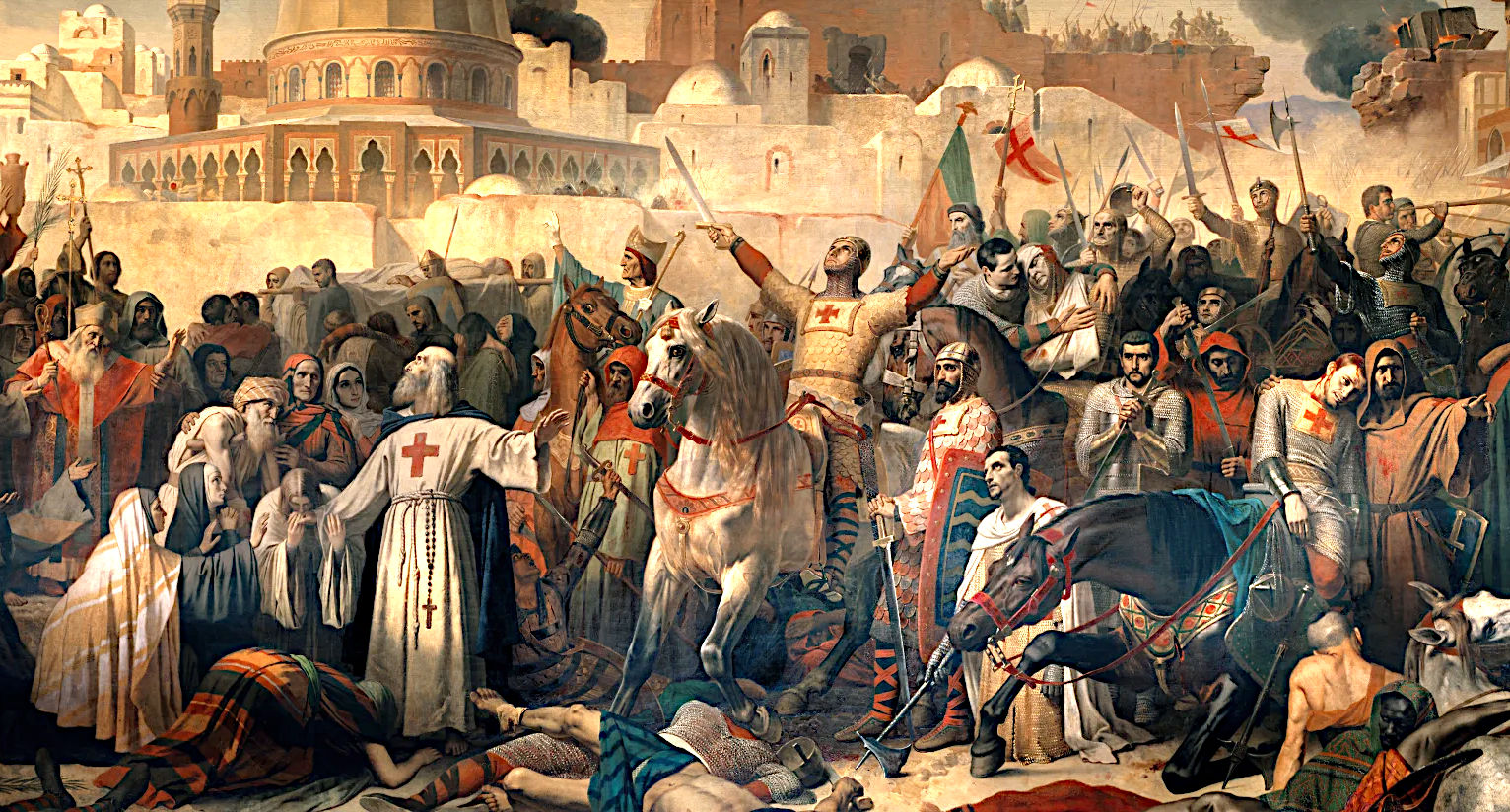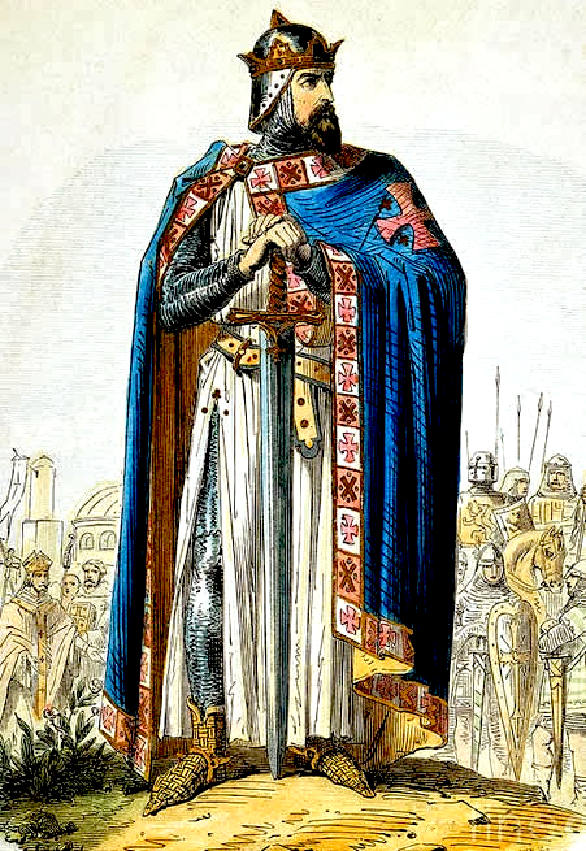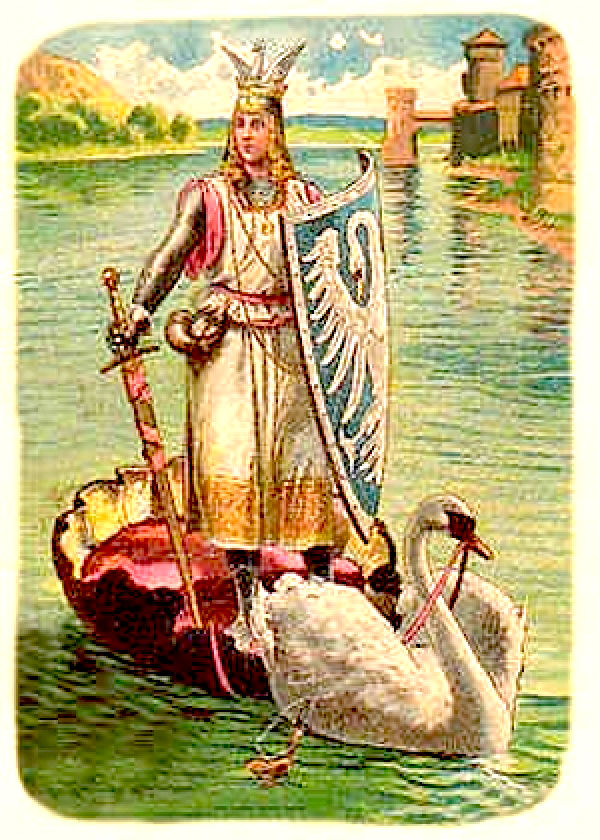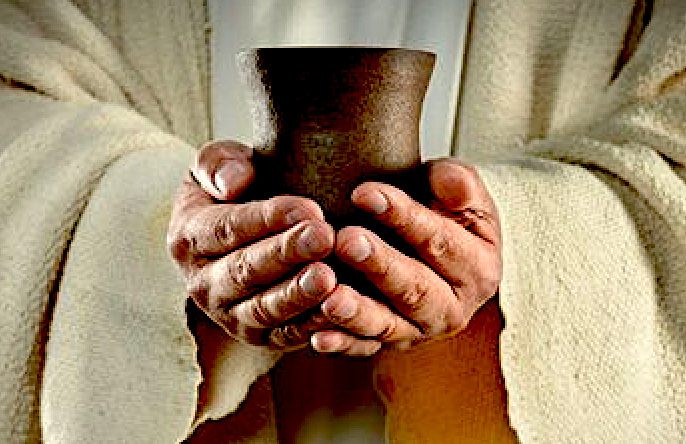
At
some point in our lives we will all feel strongly about an issue, enough
to take arms (action).
GODFREY OF BOUILLON
One of the earliest and most representative examples of a chivalrous knight was Godfrey of Bouillon (circa 1060-1100). After the 14th century, he was included among the so-called Nine Worthies: nine men through the ages (some historical, others legendary) deemed to have embodied the ideals of chivalry.
Godfrey was the son of Count Eustace II of Boulogne and Ida of Lorraine, and together with his brothers helped lead the First Crusade in 1096. Godfrey’s fame and prestige among the diverse group of barons commanding the Crusade grew so that, when the crusaders succeeded in reclaiming Jerusalem from Islamic rule in 1099, they offered Godfrey the throne of the new kingdom of Jerusalem. Godfrey, in a gesture that ticked all the chivalric boxes, refused and piously argued that no one should wear a golden crown in the city where Christ had worn the crown of thorns. Instead, he agreed to be called the Defender of the Holy Sepulcher.

Godfrey of Bouilon
Godfrey was such an exemplary knight that he became legendary. Embellished tales were written about his journey to the Holy Land and established his noble lineage. The best known of these stories is the legend of the Knight of the Swan; originally, itruc was the tale of an anonymous knight who appears in a boat drawn by a swan to rescue a damsel in distress. By the end of the 12th century, popular tellings identified the protagonist with the Bouillon dynasty and claimed that the mysterious Knight of the Swan was none other than Godfrey’s grandfather. It was a story that wove together fact and fiction around the figure of one of the most recognised knights of Christendom. This mixture of literary evocation, embellishment of reality, and celebration of chivalric values developed over a long period in medieval Europe, and especially in the Anglo-French world.
Godfrey’s mother designated him her heir, but when her father died, Emperor Henry IV confiscated the duchy, leaving Godfrey the county of Antwerp and the lordship of Bouillon in the Ardennes. Godfrey nevertheless served the emperor loyally in his campaigns in Italy and Germany, and as his reward in 1082 Henry invested him as
Duke of Lower Lorraine, but as an office rather than a hereditary fief.
Cluniac monastic influences permeated Lorraine, and their pro-papal teachings may have influenced Godfrey to take up the cross. Godfrey’s administrative skills were not sharp and perhaps he realized his future as a duke was limited and saw the Crusades as a way to achieve more.
Although he never gave up his imperial office, he sold and mortgaged some of his lands,
a clear indication he had no intention of returning from the Holy Land. Each of these reasons, and a genuine enthusiasm for the cause, probably influenced his response to the
Pope’s call. After blackmailing Jewish communities and selling parts of his holdings, Godfrey amassed funds to equip a large force.
The number of men following him gave him a great deal of prestige among other crusade leaders and drew more men to him. He was personable and with his tall, athletic frame and blond hair he appeared the ideal northern European knight and a perfect leader.
By the time the crusaders took Jerusalem, there were only two viable candidates to lead the city, Raymond of Toulouse and Godfrey. Age, experience, and his relationship with the church probably made Raymond of Toulouse the better candidate, but he was unpopular.
He too openly considered himself the secular leader of the crusaders, and his comrades viewed him as arrogant and too friendly with the emperor in Constantinople. The electors initially offered the leadership to Raymond. He refused, and said he would not wear a crown in the city where Christ wore his crown of thorns, hoping the comment would discourage others from taking the throne.
The electors offered the role to Godfrey, who hesitated, and then said he would accept the position on the grounds that he would not have to take the title of king, but could be known instead as Advocatus Sancti Sepulchri, a phrase that has been translated as “Advocate of the Holy Sepulcher” or “Defender of the Holy Sepulcher.”
Godfrey appeared sincere in his belief that the church should be the ultimate ruler in the Holy Land. After he accepted his role as ruler, Godfrey tricked Raymond into giving over control of the Tower of David, the military key to Jerusalem.
Raymond, powerless and furious, left on a pilgrimage. Initially Godfrey’s forces included approximately 300 knights and 2,000 infantrymen. He had to defend Jerusalem, the port of Jaffa, and other towns, including Lydda, Ramleh, Bethlehem, and Hebron, from hostile native forces that occupied the countryside between towns.
After falling out with Raymond, Godfrey’s relations with his nobles cooled, but most answered his call to defend the kingdom. Gradually Godfrey extended his power over the rural areas of Judea and Samaria. His reputation increased rapidly.
As his powers in the Levant increased, Godfrey’s powers in his own lands waned and he found himself increasingly at the mercy of other nobles in the Holy Land. His vassals used his cordial nature to their advantage, while churchmen knew he could not deny the church and used his trust to undermine his authority.
He needed replacements and ships, his nobles wanted political favors, and Godfrey was in no position to resist their demands. In June 1100 after a period of intense negotiations and travel, Godfrey collapsed at a hostel in Jaffa.
Rumors of poisoning passed through the court, but he likely had typhoid. He hung on for nearly a month while politicians hovered around his sickbed,
scavenging for scraps on his death. He died July 18, 1100.
He was buried as the first Christian ruler of Jerusalem on the hill of Golgotha, in the Church of the Holy Sepulcher, the site of the Crucifixion.

KNIGHT OF THE SWANN
The story of the Knight of the Swan, or Swan Knight, is a medieval tale about a mysterious rescuer who comes in a swan-drawn boat to defend a damsel, his only condition being that he must never be asked his name.
The Knight of the Swan story appears in the Old French chansons de geste of the first Crusade cycle, establishing a legendary ancestry of Godfrey of Bouillon, who in 1099 became ruler of the Kingdom of Jerusalem. Godfrey loomed large in the medieval Christian imagination, and his shadowy genealogy became a popular subject for writers of the period.
The swan-children tale occurs in the first or La Naissance du Chevalier au Cygne branch of the cycle. The texts can be classed into four versions, 1) Elioxe, 2) Beatrix, 3) an Elioxe-Beatrix composite, and 4) Isomberte. Of Isomberte no French copy survives, and it's known only from the Spanish Gran conquista de Ultramar. (Gaston Paris also used a somewhat similar classification scheme for swan-children cognate tales which he refers to as Version I.)
Elioxe follows the Dolopathos tale closest, but tells a courtlier version of the story, replacing the young lord who becomes lost with King Lothair, a ruler from beyond Hungary and the maiden with Elioxe. Lothair loses his way and stops by a fountain, and while asleep, is tended by Elioxe who comes out of the woodworks of the mountains. King Lothair decides to wed her, despite his mother's protest. However Elioxe foretells her own death giving birth to seven children, and that one of the offspring shall be king of the Orient.
While Lothair is absent warring, the queen mother Matrosilie orders a servant to carry the children in two baskets and expose them in the forest, and prepares the lie that their mother gave birth to serpents and died from their bites. The servant however had left the children by the hermit's hut, so they survive, and seven years later are discovered by a greedy courtier named Rudemart. Allured by the gold chains the children are wearing, he obtains instruction from the queen mother to steal them, but failing to take account of their numbers, misses the chain belonging to the girl. The six boys bereft of the chains fly out in swan form, and their father Lothair issues an order of protection. The king's nephew tries to hunt one of the birds to please him, but the king in a fit hurls a gold basin which breaks. Matrosilie then provides one of the necklaces to make the repair. Eventually the truth is untangled through the sister of the swan siblings. All the boys regain human form but one. While other seek their own fortunes, one boy cannot part with his brother turned permanently into a swan, and becomes Swan Knight.
In the Beatrix variants, the woman had taunted another woman over her alleged adultery, citing a multiple birth as proof of it, and was then punished with a multiple birth of her own. In the Beatrix versions, the mother is also an avenging justice. In the Isomberte variants, the woman is a princess fleeing a hated marriage.
HISTORICAL LEGENDS
Saint George is based on a soldier in the Roman army who was martyred in 303 CE (Patron saint of knights)
Sir Galahad - Knight of the Round Table 12-15th century CE literature (King Arthur legend)
Siegfried - Brunhilde & King Gunter (Kriemhild, Burgundian [Nibelung] princess) c. 1200 CE
HISTORICAL KNIGHTS
Robert Guiscard - 'The Crafty' (c. 1015-1085 CE) [Norman]
Rodrigo Díaz de Vivar - 'El Cid' (1043-1099 CE)
Godfrey of Bouillon - The Swan Knight (circa 1060-1100)
Sir William Marshal - 'The Greatest Knight that Ever Lived' (c. 1146-1219 CE)
Richard I - 'The Lionhearted' (1157-1199 CE) King of England from 1189 to 1199 CE
Sir William Wallace - Braveheart (c. 1270-1305 CE)
Sir James Douglas - 'The Black Douglas' (c. 1286-1330 CE)
Bertrand du Guesclin - 'The Eagle of Brittany' (c. 1320-1380 CE)
Edward of Woodstock - 'The Black Prince' [of Wales] (1330-1376 CE)
Sir Henry Percy - 'Hotspur' (1364-1403 CE)



